Metroid Prime 3: Quarterly Diaries #7
October 15th, 2009

Areas Covered: Imperial Caverns, GFS Valhalla, Skytram East, Sky Town
Discussion Points: Scrambled radio message and the random detour to GFS Valhalla, Skytram East’s level design, Phazon Metroid initial set piece
Imperial Caverns
Imperial Caverns has a beautiful calmness to it that really reflects on the area’s seclusion from the rest of the planet as well as the player’s quietening journey deeper into the environment. At about the most ambient point in the journey, a scrambled radio signal bursts out of your speaker—scaring the living daylights out of you and totally breaking the mood. Like all radio chatter it’s played over gameplay so it totally creeps up on the player.
Back in Bryyo you find out that it was the always intrusive Galactic Federation. Supposedly they lost your connection because of the warp point. In worried exasperation the respective Aurora Unit explains the reasons for static before pointing Samus to the abandoned GFS Valhalla. Another spot will open on the galaxy map, so away we go.
GFS Valhalla
GFS Valhalla was overrun by the space pirates and sits in a desolate sphere of space as a lonesome carrier for renegade pirates and other creatures. The visual tone of the area is typically brooding with a slick dark black and rich red aesthetic. The handful of enemy creatures still around put up an admittedly tough challenge, really puts you on edge and gives the atmosphere a sharp taste.
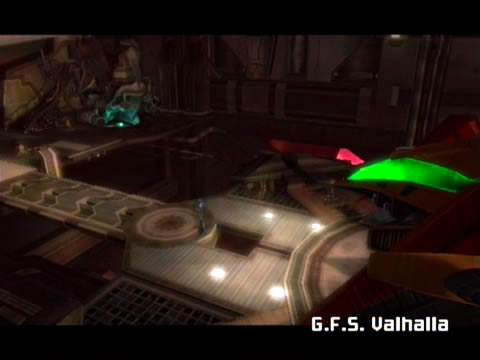
I have no idea why we were sent here though. The explanation put forward on Bryyo was simply that the place warranted investigation yet the abandoned wreck at this stage in the game has no use. After some quick exploration you’ll realize that you need four or five energy cells to re-power the station, but we don’t have the energy cells, and in fact won’t acquire any until the next area of the game! I can’t find the justification for sending you out here, particularly when the player already has an idea regarding the next point of passage (screw attack pads in Sky Town). The whole sequence, including the radio static, feels preempt, misplaced and unecessary—a red herring?
Skytram East
After screw-attacking your way up to the rather funky sky tram (everything in this area is so elegantly designed!), you arrive at the next portion of Elysia. The level design of this area is tightly interwoven and if you become too analytical (like me!) it’ll probably become confusing. The trick is to just follow your senses though, it’s all very straightforward.
Essentially, this area houses a series of bomb parts which will later be assembled and then dropped on the leviathan shield which’ll open up access to Elysia’s seed ie. the boss for this area. The player requires three things from this area: the ‘ship grapple’ upgrade (to lift the various components) and the first two individual bomb components. Acquiring the upgrade is obviously your first priority and to do that the player simply needs to make a linear trek to the opposite side of the map. The linear swing around the right-hand side works to introduce the general layout of the area, which is quite necessary given that the clump of floors in and around the three main centres can be particularly daunting. On the first romp not everything is accessible yet, which compartmentalizes your route nicely to lower areas of the map and keeps everything manageable, while at the same time teasing the unreachable areas. There’s a lot of smart layering in this section as the ship upgrade and seeker missiles manage the flow of access.
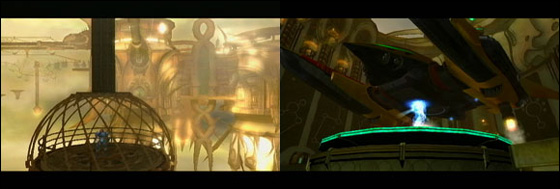
Once you reach the end and power-up your ship, the two components can be obtained in order of closest to furthest out from the end point; the design folds, accommodating the route reversal. Unfortunately the triangular, three-point design may mislead players to take the wrong route, but if you abide by the closest-to-furthest principle the design won’t pose any problems.
The ship grapple is used initially to lift a projector (large, circular mass) in the Chozo Observatory, doing so reveals a faulty circuit. Fix the circuit, drop the projector back in place and you’re given access to the upper floors. Eventually the upper route will overlap some with the route you originally took on the way in, concluding at the Concourse centre. Again we see Retro organically making clever use of the level design by interlocking different sections and having them feed into one another. I discussed this to death in the previous article, it’s prevalent throughout the series and a great design philosophy as it gives new purpose to borrowed material and allows the area to be exploited entirely by the player. In this case, by concluding at the Concourse centre the player has travelled in full circle and now has a thorough understanding of the environment. It’s makes play meaningful and this matters.
As for the room-by-room design, I think the three hub areas (centres) and the multiple floors and corridors which immediately stream off these areas are most interesting because they encompass a visual and structural design which feels very unified. This helps the level design too feel structured and organised, even though it’s all rather elaborate and could be entirely unwieldy.
Stepping back for a moment, there’s an offshoot area before the 2nd bomb component which leads to a Metroid research laboratory. This is the first time we’ve seen the nasty face rippers in Metroid Prime 3—and there’s a great sense of tension that builds up as you walk past the glass tubes of Phazon Metroids, a breed new to the series. You worm your way into the depths of this laboratory in search of the seeker missiles knowing all too well that soon these Metroids will break loose and trap you inside.* You know that the game is leading you down the garden path and it’s a real tension builder. The music is set perfectly and the transparent panels are good at making you feel cased into this danger zone, where the danger itself is highly visible.
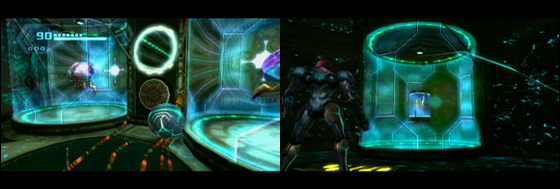
On reaching the end point, Samus must depower a shield to access the seeker missiles. Doing so will switch off the security measures and free the Metroid’s from their cylindric cages. I guess you gotta compromise, so you grab the seeker missiles and leave. The lights are out and only the surrounding alien hues provide sufficient light. The transparent flooring highlights trails of Phazon Metroids rushing their way to flank you at the exit. You literally see them scurry under the floor beneath you. There’s a wonderful feeling of dread and tension in the air. I rather enjoyed this moment, it has a typically implicit way of communicating meaning to the player which is very much traditionalist Metroid.
*You know so because Retro drop subtle clues which the player may or may not gather, and this is why I have so much respect for Retro Studios. Other developers in this industry would at this point hold up a huge sign saying “AND NOW WE’RE SETTING UP AN UBER COOL SET PIECE, I HOPE YOU’RE READY, IT’S GONNA BE AWESOME, BY THE WAY I’M THE GAME DESIGNER”. Metroid is and will always be a mature and engrossing experience simply because it respects the player by assuming that they can actually think for themselves. The developers don’t need to connect the dots or pre-boast about a forthcoming event with pretension that demeans the player. I admire games that do this and I hope to talk about it a little more in future writing.
Sky Town
After obtaining the second bomb component, the ship heads off to send supplies elsewhere and you make your way back to the Sky Town for the last part which is located in the Transit hub which we spotted on the way in. The component is locked in place and requires the seeker missiles to break from its lock. Now we have all of the upgrades for this area, bar the spider ball which we don’t get until later.
Additional Readings
Metroid Prime 3 Wikitroid Entry
Metroid Prime 3: Quarterly Diaries #6
October 12th, 2009

As of this post I’m live, writing as I play, which’ll likely mean that after the next two posts I’ll hit a stump. Let’s see how far I can ride this train. Toot! Toot!
Areas Covered: Elysia (Main Docking Bay), Bryyo (Revisited 2nd), Imperial Caverns
Discussion Points: Backtracking, Tutorializing backtracking, Ghor battle, suit design, Imperial Caverns’ cyclic level design, Imperial Caverns and Phendrana Drifts
Elysia (Main Docking Bay)
As I moaned about for far too long in the Bryyo portion of my walk-through, backtracking is a chief concern of mine. Thankfully Retro have cut out a lot of backtracking (or at least removed the boredom out of it) for the next few sequences in the game. This’ll be the key point of discussion for the next stretch, so pay attention!
The trek back to your ship in pursuit of Ghor is treated as part of the continual training of the boost ball technique. The boost ball is required in generating power for the cannons which shorten your route back to the ship. The re-routing gives the environment a bit of zest, as is usually the case for good backtracking. Furthermore, as you probably noticed on your way in, there is a series of half pipes and other devices which each require the boost ball. These devices all aid in rejuvenating the path back to your ship as well as familiarizing you with the various applications of the boost ball technique.
I suppose I ought to talk about the fight with Ghor now, but I honestly don’t feel like discussing it. I can’t say that it was another regurgitation of the oft-repeated outer shell, inner core design, but simply put, the battle just felt stale and unresponsive. To make matters worse, Ghor’s clunky armor is an eyesore to look at. Another assurance that almost all of the boss battles up to this point have been a sour-y letdown. On the flip-side the plasma beam is awesome. ^_^

The plasma beam will probably trigger off a pulse in your brain reminding you of all those ice blockages throughout Bryyo. It’s a pity then that the ship is damaged and in a self-healing mode, meaning one thing: back to the Aurora Unit! It’s another retread, however Retro have twice managed to avoid the grind of repetition by again pinching from page 251 in the rule book of Nintendo game design which states “new abilities equals new ways of subverting troublesome backtracking”. This time the plasma beam can clear rubble lying around cannons, ziplining back to your destination. Again, backtracking becomes a tutorial. The cannons integrate well in the open environment and allow for new routes to be mapped onto the existing path structure.
I love Nintendo games, they all utilize the same shared set of common-sense design principles. Did you take note of the block-the-exit-with-obstacle-that-requires-the-new-ability trick after the Ghor battle? You should have, they’ve been pulling that one forever.
Anyways, after using the plasma beam in a series of welding exercises, the Aurora Unit will blabber some nonsense about leviathans, shields and some over-sized components. I really like Samus’ powerful stance and the angle which frames her in this sequence. There’s something visually attractive about the subdued colours and exoskeleton frame of Samus’ suit. She’s not quite human nor does she bear much resemblance to a space marine. Something about the design commands respect and I can’t quite put my finger on it. Flag this idea for another article.

With obligations aside you can go back to Bryyo and unearth whatever’s behind the frozen blockages. On the way you’ll stumble upon the green wall panels in Sky Town. The Aurora Unit will alert you that the required upgrade (screw attack) is available on Bryyo. Planting a seed and foreshadowing the next interval of gameplay. Another neat trick.
Bryyo (Revisited 2nd)
Heading back to Bryyo resurrects some old dilemmas: which airdock do you stop off at? Both places have uses for the plasma beam, which choice is the right one; the one with the screw attack? Fortunately making the wrong decision won’t punish you. Firey Airdock progresses the story while Cliffside Airdock sends you on an impressive upgrade trail which spirals around previous areas in a stupefying fashion. Damn. Retro are pulling out all the stops when it comes to addressing my previous complaints!
The same tutorial/backtracking trick is still in operation on your way back through Bryyo. It doesn’t take long before you find a warp which’ll take you to Imperial Caverns. A warp? Ok, this seems a little strange (why not just connect the two areas?), but I swear it’s happened before in a Metroid game. Oh yeah, Metroid Prime 2, light-dark world portals.
Imperial Caverns
Players of the original Metroid Prime will likely feel sentimental towards Imperial Caverns. It’s a visual copy and paste of the much adored Phendrana Drifts. Sadly the assets appear to be ripped straight from 2002 with no considerable servicing to speak of. It’s unfortunate as it dampens much of the charm and makes everything feel a little old.
Imperial Caverns only houses the screw attack upgrade and not much else, giving it a relatively minor and, considering it’s connection to the rest of the planet, obscure presence in the scope of things.
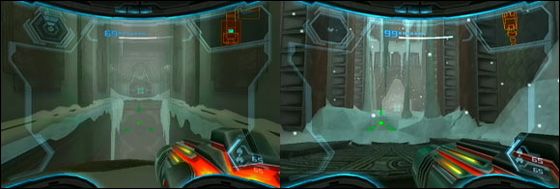
I really dig the cyclic level design of this area, it clearly communicates to the player that they’ve traversed in a loop by structurally designing the caverns in series of circular shapes. Much of Metroid’s level design operates in a loop fashion; you enter an area, acquire a weapon and then loop your way to your initial starting point. It’s just in this area the structural design paints an appreciable representation. The verticality helps too, not sure that I’m in favour of smashing the floors of ice though.
Side note: I figured out my problems with the Sky Town map. Basically the different floors are connect to the exterior hub. Sometimes the ground floor will connect to a centre point which then sends you to the first floor of another area. When looking at it from above (as the map is presented) it’s difficult to determine which floors contain the appropriate exits. That is, unless you zoom in right up close, but that becomes a hassle into itself.
Another random aside: I just figured out why the ice missiles have the ice property. Freezing make-shift platforms is a compulsory part of your repertoire, by assigning ice properties to the missiles there can be no conflict from the regular beam. Incidentally the regular (plasma) beam achieves the opposite purpose by melting ice and is in the same way assigned.
Additional Readings
Nintendo’s Video Game Masterpiece – ABC News
Metroid Prime 3: Quarterly Diaries #5
October 8th, 2009

Areas Covered: Elysia (Main Docking Bay)
Discussion Points: Hyper ball, Skytown Central Hub (my personal amnesia), engineering and interaction, Defense Drone mini-boss, Boost ball, license to kill
Elysia (Main Docking Bay)
In my last article I forgot to talk about the hyper ball ability gained after defeating Mogenar. Hyper ball allows Samus to enter hyper mode while in morph ball mode. The significance being that she can now radiate phazon to destroy overgrowth and other such matter. Considering that the morph ball bombs already do this, it seems like a needless addition and a pitiful award for the end of a chapter.
Anyways, back to schedule. I want to remark on the hub areas of Sky Town, but I’m not sure if my criticisms will be preempt and therefore unjust. Well, here goes…this area, much like the landing zones on Bryyo, often left me in limbo on where to go next, resulting in plenty of aimless wandering. Sky Town is a complicated web of multi-storied islands, so I naturally relied on the map quite heavily for directions. Yet, it seems as though the map screen split the world in a way in which I still can’t quite wrap my head around. There are at least two stories filling the interiors of the Sky Town area, yet the map seems to display only one floor at a time (the one you’re occupying). What made it tricky are the outdoor conduits and hubs which are represented the same on either floor. Maybe they aren’t, I need to seriously go back and check my facts, but it’s a tangle all the same.
In typical, if not a little excessive, Metroid fashion, the Sky Town area is riddled with plenty of new devices which drop obvious clues for the next slew of weapon upgrade. More points of interest to mentally flag down. Check. If you’ve played previous games, the respective power ups are obvious. In fact, your initial walk-through of Sky Town is practically a runway of upgrades including the boost ball, seeker missiles, spider ball and plasma beam. It’s a nice way to entice returning players in this way, I think.
It was somewhere around this point too where I got awarded the 400 kills achievement (and a stylish kill achievement for fending off the Steamlord). I don’t really like Retro using the word “kill” in a Metroid game. It doesn’t fit with the Metroid legacy nor the first person adventure (rather than FPS) theme of the Metroid Prime sub-series.
http://www.youtube.com/watch?v=LIfz_VJ5e8s</a>
Fast forward to 7 minutes in to see the room I am refering to, mind the commentary too.
Just before the Defense Drone mini-boss is a room called “Construction Bay” which I find of particular interest. Metroid Prime 3, most obviously with the boss battles already discussed, tends to layer abilities on top of each other to create interesting logic puzzles. It’s no new trick, but it’s clear in Metroid Prime 3 that Retro have become seasoned experts at composing these scenarios, and it makes Metroid Prime 3 feel all the more enjoyable. I like this room because of the way they pull in multiple assets and abilities into a single structure. You have the gates, also used on the flying fox, reused here along with the charge shot, grip pads, morph ball and grapple beam abilities. You must use the grip pads to climb up to the upper level of this structure and then crawl through a tunnel in morph ball mode to disarm the under-hanging gates so that you can freely swing across to the other side with the grapple beam. Your actions around the supporting structure, make you feel like part of the engineering and it allows you to appreciate not only the design but what the design speaks of in terms of cultural lore. By disarming the security measures it creates something of a kinship with it in understanding how it operates.
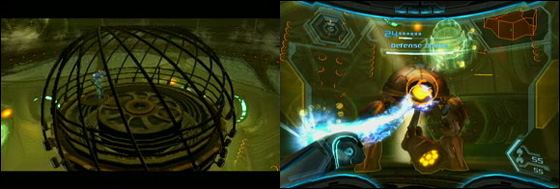
In the following room you’ll find an innocent looking upgrade. Walking towards it will prompt a cutscene with the power-up dropping beneath the floor. A barred, spherical cage then suddenly clamps around Samus, descending into an arena below. The cage retracts back into the floor and Samus is faced with the Defence Drone mini-boss. It’s a pretty spectacular opening. Not much needs to be said about the defence drone though, it’s another pasting of inner core, outer core et al design.
The boost ball ability left behind is much more interesting, or rather its application is. Previously in Metroid Prime 1 & 2 the boost ball was used to gain momentum along half-pipes and push against inclines. These applications still exist in Metroid Prime 3, but, at least for the time being, the boost is used to built up kinetic energy along circular tracks. The design suitably plugs back into the industrialised aspects of Sky Town’s aesthetic. Again, your participating in the engineering of the place.
With the boost ball you can now open the door blocking off the Aurora Unit. Yeah, I forgot to mention – your objective is to get the Aurora Unit back online to the main network. The Mother Brain-esque unit (just like the one on Olympus) is unhealthy, requiring you to enter an area underneath the main chamber and administer an antidote.

The Aurora Unit is a super interesting character due to it’s unmistakable similarities with Mother Brain. This is definitely no coincidence. Video from the Metroid channel Nintendo offered near release is also suggestive towards this assumption (see the end of the trailer, kinda suspicious, huh?). Colour me intrigued.
Once you’ve restored health to the unit, a corrupted Ghor reveals himself and uses his plasma beam to damage the mainframe and disconnect the unit from the main network. Ghor’s robotic nature makes him a suitable canidate for this area. I always liked Ghor because he’s just an asshole instead of a chest-beater like the other bounty hunters.
Shortly afterwards, the Aurora Unit asks you to obtain the plasma beam from Ghor, presenting an unusual dynamic which evoked a personal response. I’m not sure, something about this sequence felt out of place in a Metroid game, experimental yet at the same time within its means. There are two faces to this, let me cover them individually:
Bounty Hunter
Samus may be a bounty hunter, but she isn’t a gun for hire, she’s an investigator hired to check out conflict. The series has always made this distinction by presenting violence in a faceless manner, with Samus simply following through with her role as a law enforcer. Yet, in this off-beat moment you’re implicitly asked to kill with necessesary spoils granted for progress. Although the request isn’t overt about killing (acquire the plasma beam which is grafted onto Ghor who has gone rogue, hmm…I wonder what that involves), rarely has the series “discussed” your actions before with such loudness. Secondly, and maybe more importantly (I’m not too sure), you’re asked to attack a human-like creature rather than the local fauna/possessed version thereof. This is true of the other bounty hunters too though, but the games quite abruptly requested me to kill something non-plant-like, and that, to me, feels obtuse given the context. Maybe we’ll have to explore this one a little later.
The Ship
Upon leaving, transmissions chime in alerting you that your ship’s taking heavy damage. For some reason the destruction of my ship hastened my rush back to save the damned thing. It felt like a very urgent situation. The ship is practically the only other re-occuring “character” in the franchise, so you actually care about saving it from Ghor. I found that the transmission (two in total) legitimized my pursuit and eventual destruction of Ghor.’Ship as secondary character of Metroid series’, seems like another topic which warrants further investigation. Another time, another time.
Additional Readings
Commentaries and Examples of Work by Environment Artist



 Game Design Companion: A Critical Analysis of Wario Land 4 - $7.99
Game Design Companion: A Critical Analysis of Wario Land 4 - $7.99 Level Design: Processes and Experiences
Level Design: Processes and Experiences Speed Boost: The Hidden Secrets Behind Arcade Racing Design - $5.99
Speed Boost: The Hidden Secrets Behind Arcade Racing Design - $5.99 Adventures in Games Analysis: Volume I - $5.99
Adventures in Games Analysis: Volume I - $5.99







